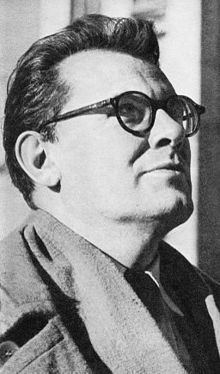Jerzy Hryniewiecki
Jerzy Hryniewiecki (born April 21, 1908 in Dorpat (today: Tartu, Estonia), Livonia , Russian Empire ; † August 21, 1989 in Warsaw ) was a Polish architect , university lecturer , town planner and planner for industrial and sports projects and other buildings for the public.
Life
Hryniewiecki was born in Dorpat in the former Livonia governorate of the Russian Empire. There his father was a lecturer in biology at the University of Dorpat . After the First World War he attended the high school and lyceum Stefan Batory in Warsaw and took part in the establishment of the Polish scout movement in a leading position. After graduating from high school, he studied at the Warsaw University of Technology . During his studies he visited many countries in Europe and the Middle East and did internships in Czechoslovakia and Holland .
1931 Hryniewiecki was trained at the School of the reserve artillery in Włodzimierz Wołyński in Volyn today in the Ukraine and was antiaircraft - artillery than in Warsaw reservist assigned. In the following years he improved his language skills in Russian, Italian and English and learned German.
career
From 1937 he worked in the Warsaw City Planning Office and was also the district architect of Mokotów . He also worked on the Polish exhibition pavilions for the 1937 World's Fair in Paris and the 1939 World's Fair in New York City . In 1939 he was mobilized and stationed with the air defense in the Tucheler Heide in what was formerly West Prussia . After the surrender of his unit, which had previously been awarded for bravery, he was first held in Spittal an der Drau in Carinthia and later in officers' camp II C in Woldenburg in the then Pomeranian Neumark . He returned to Poland on January 30, 1945.
In 1946 Hryniewiecki became a professor at the Technical University in Warsaw and, as a member of the Warsaw Bureau for Industrial Buildings, planned, among other things , the H. Cegielski factory in Poznan , the Bierut hut in Częstochowa , and the “FSO” passenger car factory ( Fabryka Samochodów Osobowych ) in Żerań in the north Warsaw and the truck factory in Lublin . He also planned various exhibitions of the People's Republic of Poland at home and abroad.
Hryniewiecki was an independent member of the Polish parliament, the Sejm , in the second and third legislative periods and temporarily chairman of the Association of Architects of the Polish Republic ( SARP ). He was buried in the Powązki cemetery in Warsaw .
Prizes and awards
- 1977: Honorary Award of the Association of Architects of the Polish Republic
- 1980: Dr. hc from Cracow University of Technology
Planning and buildings (selection)
- 1948: planning and execution of the "Exhibition of the Recovered Territories " ( Polish Wystawa zien Odzyskanych ) in the architect Max Berg built 1913 Centennial Hall in Wroclaw .
- 1953 to 1955: 10th Anniversary Stadium , Praga , Warsaw, together in Zbigniew Ihnatowicz and Jerzy Sołtan .
- 1959 to 1962: Supersam supermarket in Warsaw.
- 1960 to 1971: Spodek sports hall (“Flying Saucer”) in Katowice , Upper Silesia .
Individual evidence
| personal data | |
|---|---|
| SURNAME | Hryniewiecki, Jerzy |
| BRIEF DESCRIPTION | Polish architect, urban planner, university professor and member of the Sejm |
| DATE OF BIRTH | April 21, 1908 |
| PLACE OF BIRTH | Dorpat , Livonia Governorate , Russian Empire |
| DATE OF DEATH | August 21, 1989 |
| Place of death | Warsaw , Poland |
